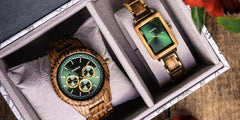Aviator sunglasses have long transcended their military beginnings. Worn by icons and adventurers alike, they represent confidence and clarity. Treehut, known for handcrafted wooden timepieces, brings that same dedication to detail into eyewear with the Top Gun aviator collection. If you're shopping for someone special or upgrading your everyday gear, the choice between polarized vs. non-polarized aviators can shape both form and function.
Read More: Wayfarer vs. Aviator: Which Sunglasses Suit You Best?
Polarized vs. Non-Polarized: What’s the Difference, Really?
Let’s break it down. Polarized sunglasses for men contain a special filter that blocks intense reflected light, especially horizontal glare. This type of glare is common on surfaces like water, glass, and snow. Polarization enhances clarity by reducing strain on the eyes during bright conditions.
Non-polarized lenses, on the other hand, reduce brightness without filtering out this glare. They provide uniform shading and are ideal for indoor-outdoor transitions or screen use. Understanding this core difference helps clarify the polarized vs. non-polarized aviators question.
The Benefits of Polarized Sunglasses for Outdoor Enthusiasts

For those who spend hours outside, polarized lenses offer meaningful advantages:
- Glare reduction: Especially effective during sunrise and sunset commutes, or along reflective water surfaces.
- Enhanced color: Colors appear more vivid, which improves depth perception.
- Eye comfort: Polarization significantly lowers squinting and fatigue.
Imagine fishing on a lake, biking down coastal highways, or navigating snowy mountain trails. In these environments, polarized vs. non-polarized aviators becomes a question of clarity and comfort. Polarized lenses help you stay focused and energized through changing light.
Non-Polarized Lenses: When Simplicity Wins

There are specific use cases where non-polarized lenses excel:
- Instrument clarity: Pilots prefer them because polarization can interfere with reading cockpit displays.
- Digital visibility: Screens on phones, tablets, and dashboards remain fully visible without distortion.
- Light consistency: They provide uniform shading, ideal for photographers or indoor-outdoor transitions.
- Versatility: Suitable for environments with low glare or where quick adaptation to varying light is needed.
Non-polarized aviators are excellent for those who move between indoor and outdoor settings. They also offer visual consistency and ease of use with screens – smartphones, dashboards, tablets. In the polarized vs. non-polarized aviators comparison, they make sense for tech-forward lifestyles and low-glare conditions.
Aviator Sunglasses Buying Guide
Lens type is just one part of the equation. Before committing, consider these other key elements:
- Frame material: Metal offers durability; wood or acetate gives a warm, tactile feel.
- Lens color: Gray maintains true color balance; brown adds contrast in variable light.
- UV protection: Always look for lenses that block 100% of UVA and UVB rays.
- Fit and comfort: Adjustable nose pads and lightweight frames ensure wearability all day.
- Gifting potential: Is this a surprise for someone? Treehut offers engraved messages that add a heartfelt touch.
The polarized vs. non-polarized aviators debate fits within this broader decision tree. Prioritize the features that support daily routines and elevate personal style.
Personal Style vs. Purpose: What Matters Most to You?
Once you've covered the technical aspects, think about personal use. Do you commute by car during golden hour? Spend weekends hiking under open skies? Or is this a gift for someone who travels often or leads a fast-paced life?
Polarized lenses support visual performance in variable conditions, while non-polarized lenses match fast transitions and tech usage. Each option reflects different priorities, but both lead to elevated experiences. When considering polarized vs. non-polarized aviators, context shapes the best fit.
Read More: Best Wooden Glasses for 2025: Top Stylish Picks
Discover the Best Aviators for Eye Protection at Treehut
Treehut designs its aviators with natural aesthetics and everyday resilience. These aren’t mass-produced frames – each pair is carefully crafted, combining stainless steel or wood accents with scratch-resistant lenses. Whether you choose polarized or non-polarized, every lens in the Top Gun line includes full-spectrum UV protection. That means you’re covered for brightness, clarity, and long-term eye health.
What sets Treehut apart isn't just the materials. It’s the values behind the brand: sustainability, family, and personalized gifting. The aviator collection reflects those ideals with custom engraving, thoughtful packaging, and a finish that balances performance with emotional value.



























